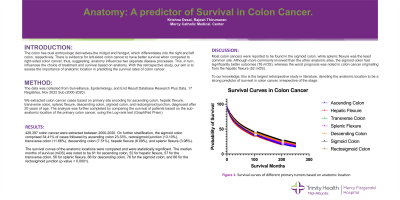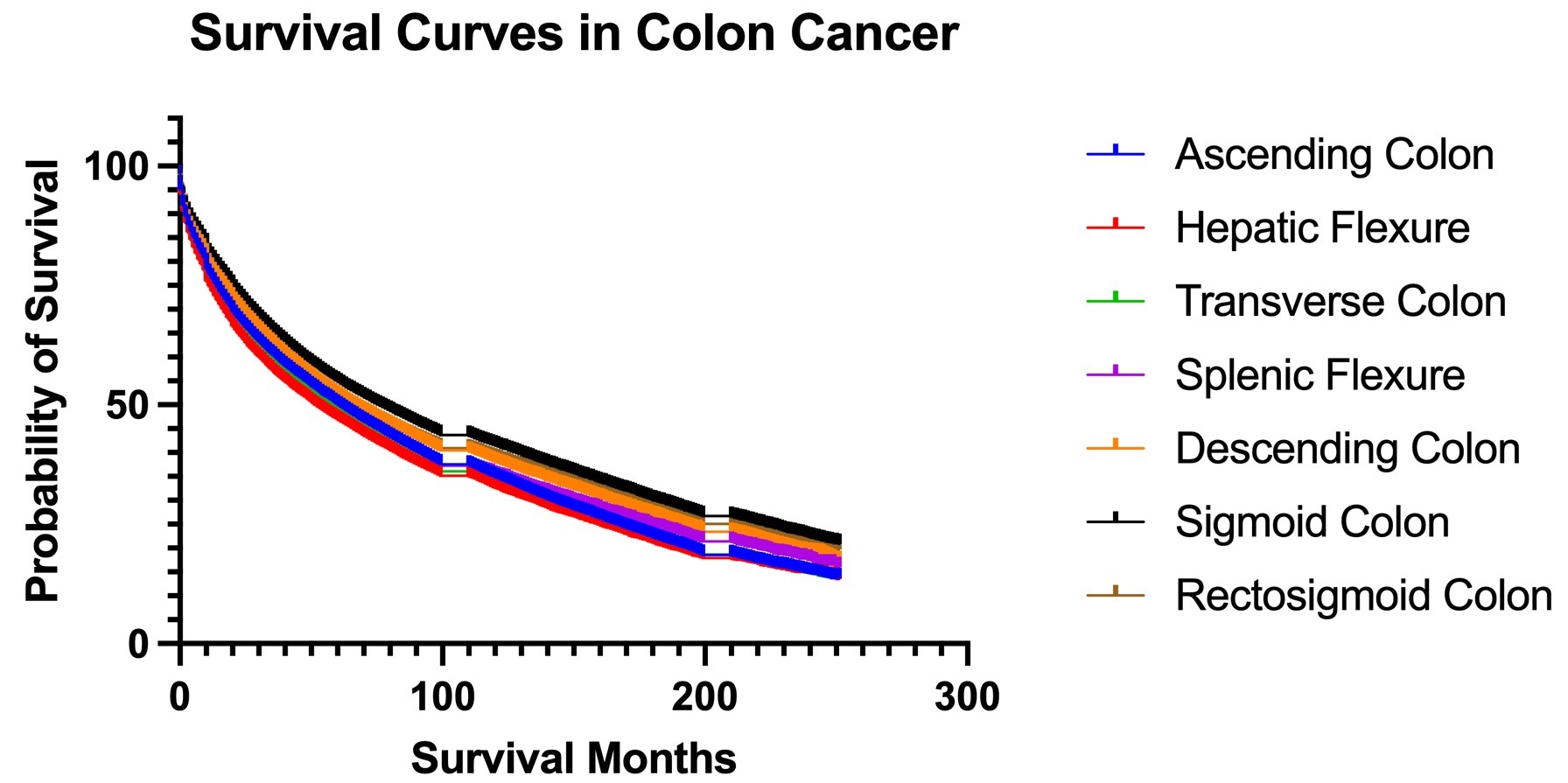Monday Poster Session
Category: Colon
P1623 - Anatomy: A Predictor of Survival in Colon Cancer
Monday, October 23, 2023
10:30 AM - 4:15 PM PT
Location: Exhibit Hall

Has Audio

Krishna Desai, MD
Mercy Catholic Medical Center
Philadelphia, PA
Presenting Author(s)
Krishna Desai, MD1, Rajesh Thirumaran, MD2
1Mercy Catholic Medical Center, Philadelphia, PA; 2Mercy Catholic Medical Center, Darby, PA
Introduction: The colon has dual embryologic derivatives-the midgut and hindgut, which differentiates into the right and left colon, respectively. There is evidence for left-sided colon cancer to have better survival when compared to right-sided colon cancer, thus, suggesting, anatomy influences two separate disease processes. This, in turn, influences the choice of treatment and survival based on anatomy. With this retrospective study, our aim is to assess the importance of anatomic location in predicting the survival rates of colon cancer.
Methods: The data was collected from Surveillance, Epidemiology, and End Result Database Research Plus Data, 17 Registries, Nov 2022 Sub (2000-2020). We extracted colon cancer cases based on primary site encoding for ascending colon, hepatic flexure, transverse colon, splenic flexure, descending colon, sigmoid colon, and rectosigmoid junction, diagnosed after 20 years of age. The analysis was further completed by comparing the survival of patients based on the sub-anatomic location of the primary colon cancer, using the Log-rank test (GraphPad Prism).
Results:
428,397 colon cancer were extracted between 2000-2020. On further stratification, the sigmoid colon comprised 34.41% of cases followed by ascending colon 23.33%, rectosigmoid junction (13.10%), transverse colon (11.66%), descending colon (7.51%), hepatic flexure (6.09%), and splenic flexure (3.98%). The survival curves of the anatomic locations were compared and were statistically significant. The median months of survival (mOS) was noted to be 61 for ascending colon, 52 for hepatic flexure, 57 for the transverse colon, 56 for splenic flexure, 66 for descending colon, 76 for the sigmoid colon, and 66 for the rectosigmoid junction (p-value < 0.0001).
Discussion: Most colon cancers were reported to be found in the sigmoid colon, while splenic flexure was the least common site. Although more commonly involved than the other anatomic sites, the sigmoid colon had significantly better outcomes (76 mOS), whereas the worst prognosis was noted in colon cancer originating from the hepatic flexure (52 mOS). To our knowledge, this is the largest retrospective study in literature, denoting the anatomic location to be a strong predictor of survival in colon cancer, irrespective of the stage.

Disclosures:
Krishna Desai, MD1, Rajesh Thirumaran, MD2. P1623 - Anatomy: A Predictor of Survival in Colon Cancer, ACG 2023 Annual Scientific Meeting Abstracts. Vancouver, BC, Canada: American College of Gastroenterology.
1Mercy Catholic Medical Center, Philadelphia, PA; 2Mercy Catholic Medical Center, Darby, PA
Introduction: The colon has dual embryologic derivatives-the midgut and hindgut, which differentiates into the right and left colon, respectively. There is evidence for left-sided colon cancer to have better survival when compared to right-sided colon cancer, thus, suggesting, anatomy influences two separate disease processes. This, in turn, influences the choice of treatment and survival based on anatomy. With this retrospective study, our aim is to assess the importance of anatomic location in predicting the survival rates of colon cancer.
Methods: The data was collected from Surveillance, Epidemiology, and End Result Database Research Plus Data, 17 Registries, Nov 2022 Sub (2000-2020). We extracted colon cancer cases based on primary site encoding for ascending colon, hepatic flexure, transverse colon, splenic flexure, descending colon, sigmoid colon, and rectosigmoid junction, diagnosed after 20 years of age. The analysis was further completed by comparing the survival of patients based on the sub-anatomic location of the primary colon cancer, using the Log-rank test (GraphPad Prism).
Results:
428,397 colon cancer were extracted between 2000-2020. On further stratification, the sigmoid colon comprised 34.41% of cases followed by ascending colon 23.33%, rectosigmoid junction (13.10%), transverse colon (11.66%), descending colon (7.51%), hepatic flexure (6.09%), and splenic flexure (3.98%). The survival curves of the anatomic locations were compared and were statistically significant. The median months of survival (mOS) was noted to be 61 for ascending colon, 52 for hepatic flexure, 57 for the transverse colon, 56 for splenic flexure, 66 for descending colon, 76 for the sigmoid colon, and 66 for the rectosigmoid junction (p-value < 0.0001).
Discussion: Most colon cancers were reported to be found in the sigmoid colon, while splenic flexure was the least common site. Although more commonly involved than the other anatomic sites, the sigmoid colon had significantly better outcomes (76 mOS), whereas the worst prognosis was noted in colon cancer originating from the hepatic flexure (52 mOS). To our knowledge, this is the largest retrospective study in literature, denoting the anatomic location to be a strong predictor of survival in colon cancer, irrespective of the stage.

Figure: Survival curves of different primary tumors based on anatomic location
Disclosures:
Krishna Desai indicated no relevant financial relationships.
Rajesh Thirumaran indicated no relevant financial relationships.
Krishna Desai, MD1, Rajesh Thirumaran, MD2. P1623 - Anatomy: A Predictor of Survival in Colon Cancer, ACG 2023 Annual Scientific Meeting Abstracts. Vancouver, BC, Canada: American College of Gastroenterology.
